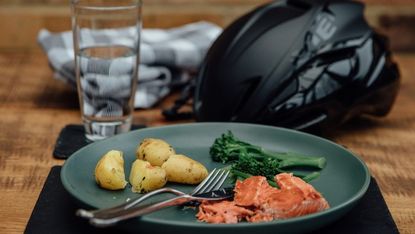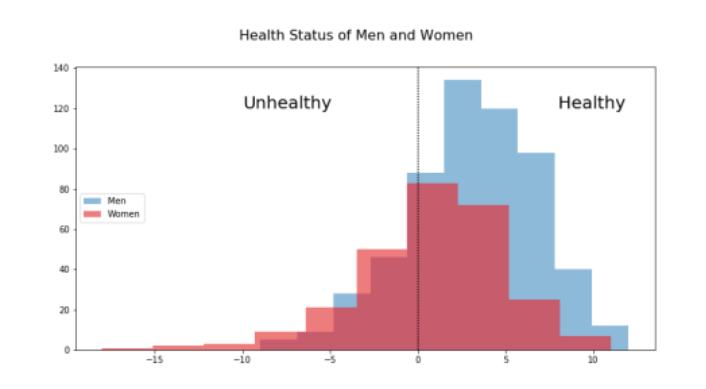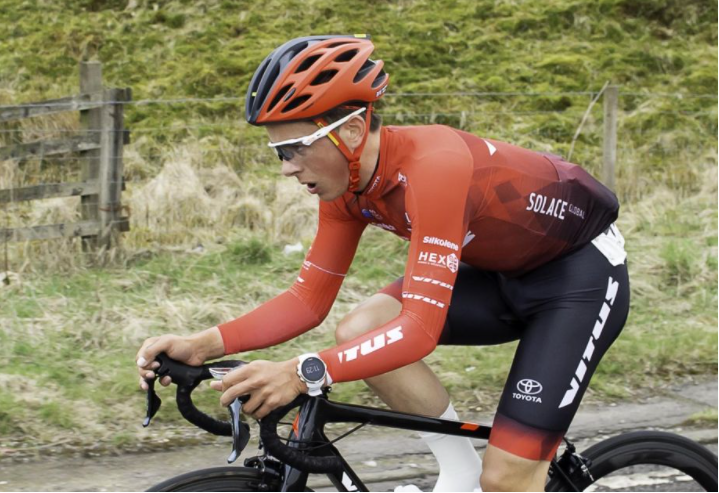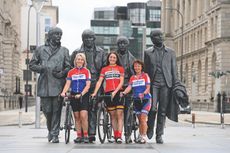RED-S and cycling: Could you be affected by cycling’s hidden under-fuelling epidemic?
As a CW survey reveals that one in five amateur riders are putting their health at risk by under-fuelling, Michelle Arthurs-Brennan investigates how to identify the signs and always meet energy demands
- (opens in new tab)
- (opens in new tab)
- (opens in new tab)
- Sign up to our newsletter Newsletter


A Cycling Weekly survey has shown that under-fuelling in cycling has reached epidemic proportions. In a survey of 868 riders, one in five riders indicated that they are putting their health at risk by failing to properly replenish energy. Are you among them? The likelihood is greater than you might think.
My own experience of under-fuelling began almost a decade ago when my periods stopped in my early 20s. I asked a coach if I should be worried. “Not at all,” she responded. “When I was a pro, no one had periods.”
My GP was equally dismissive: “Not having periods is quite normal in exercising women,” she told me, wrongly. “It’ll all even out when you stop training.” I went back three times during my 20s. Each GP sent me for blood tests and ultrasounds (ruling out alternative causes) and arrived at the same conclusion: everything was fine and my cycle would return when I decided to stop exercising so much. Speaking to fellow female amateur racers revealed that most of us were in a similar boat. Again and again, I was told I should just stop worrying.
But I was worried. My research led me to the ‘female athlete triad’, a condition involving low energy availability, sometimes disordered eating, menstrual dysfunction and low bone density. However, most case studies involved underweight runners whose problems are flagged up by stress fractures. My body fat percentage was slap bang in the middle of ‘normal’, so there was nothing to indicate that I was in a high-risk category.
I was right to be worried. Recent research has confirmed the prevalence and seriousness of under-fuelling — and men are at risk as well as women. The problem is referred to by sports medics as relative energy deficiency in sport, or RED-S — it is, in simple terms, a chronic or repeated mismatch between energy demand and energy intake. The result in women is a shutdown in the reproductive system — no periods and reduced oestrogen — and in men reduced testosterone. In both sexes, over time the energy shortfall can lead to reduced bone density and increased risk of fractures as well as diminished training gains (see further down the page for an explanation of the link to bone health).
Under-fuelling is more common than you might think: our Cycling Weekly reader survey found that across all respondents, 30 per cent of female and 15 per cent of male respondents exhibit symptoms of RED-S. The number increased to 40 and 36 per cent in semi-professionals, the highest risk group (there’s a breakdown of the data towards the end of this feature).
In female cyclists not on hormonal contraception, 39 per cent reported menstrual dysfunction with gaps of longer than six months in menstruation — and up to 20 years. It is worth noting that some cyclists reported being prescribed hormonal contraceptives to counter a lack of natural period, these riders were therefore not included in the 39 per cent, suggesting the actual number of female cyclists affected is much higher.
Two common misconceptions hide the scale of the problem: that someone who’s under-fuelling will inevitably be underweight and have a troubled relationship with food. Neither is true. If energy availability is reduced, the body compensates by reducing metabolic rate while adjusting hormone systems to save energy — therefore, low weight isn’t always a marker.

The CW survey showed a surprising number of riders in the unhealthy zone, using criteria set by experts in endocrynology
Slipping into energy deficiency trouble doesn’t mean you’re under-fuelled all day every day; even short-lived episodes of low energy availability over a day, such as under-fuelled exercise sessions, are bad news — even if your total intake of calories across the whole day is sufficient.
It was only when I listened to the advice of endocrinologist Dr Nicky Keay (opens in new tab) and started paying attention to the timing of my fuelling, increasing carbohydrate intake strategically around training - something that's very easy for athletes juggling full-time jobs to overlook - that my body kicked itself back into action.
How RED-S is affecting athletes

Harrison Jones has since stepped away from cycling
Our survey showed that the effects of under-fuelling are hampering cyclists across the spectrum, from those just racing for fun to professionals. However, the culture at the top certainly influences the rest of us.
Harrison Jones is a 22-year-old cat-one racer, formerly with Vitus Pro Cycling, who raced with Division One team GSC Blagnac in 2019 but has now decided to step away from the sport. The pressure to stay as light and lean as possible left him feeling depleted, struggling to sleep and feeling self-conscious about his appearance.

“Although I know that I need to be fuelling myself properly,” Jones told me, “being in that environment all the time, the pressure made me feel unprofessional if I ate enough. Under-fuelling and being constantly depleted definitely made me see the sport in a negative light.”
After being banned for 10 months for a positive test for methylhexaneamine during the 2018 Tour of Croatia, WorldTour pro Janiez Brajkovic claimed that the stimulant had consumed inadvertently in a meal replacement shake he was using while suffering from bulimia.
“Eating disorders are common in the pro peloton,” Brajkovic told CW, “and they come on a spectrum [from disordered eating to pathological eating disorder]… The environment definitely plays a role. In all sports, athletes will push their bodies to the limit, whether it’s by training [too hard] or restricting food too much.”
Though losing weight might seem like a shortcut to faster cycling, it very easily backfires. If your body is struggling to maintain the basic biological function of reproduction and bone health, it sure as hell isn’t bothered about your 25-mile time trial time.
When the endocrine system isn’t working, nature’s goodies — such as growth hormone, which helps you to build muscle — are disarmed and body fat is retained as metabolism slows down. Eating less doesn’t always make you leaner, and certainly not fitter.
A 2018 study that looked at male cyclists found that those in low energy availability scored fewer British Cycling points over the course of a year and had lower testosterone than those fuelling adequately. Research by sports analyst Gavin Francis (science4performance.com) concluded that successful pro cyclists had a healthy BMI.

Georgia Williams leads the bunch in 2019
After a season-long effort to regain her menstrual cycle, Mitchelton-Scott pro Georgia Williams allowed herself to gain some weight — and as a result her energy levels and health have improved. The two-time New Zealand national time trial champion had a wake-up call in early 2018 when a crash left her with multiple fractures.
“I had spoken to a doctor in 2013 who said it was normal not to have periods and suggested I go back on the pill,” the 26-year-old told us. “After my crash in 2018, a doctor referred me to an endocrinologist who looked at my bone scan results and said my spine was in the osteoporosis zone. Then I knew I had to put my health first.”
Williams’s bone density in her spine was measured at -3.1 on a score where minus one is considered normal, as rated by the World Health Organization (WHO).
“I was open about my problem, and the sports director at my team was very understanding and helpful. Since then, several riders have got in touch and told me they have the same problem.”
For Williams, the key was upping her fuel intake, particularly carbs before, during and after rides.
“It took months of putting a really big focus on fuelling to get my menstrual cycle back. In the end, I started my first period in over four years on an altitude training camp in Andorra. I cried, I was so happy. That showed me that it’s definitely possible to train hard and still maintain hormone balance.”
Williams gained 6kg from a starting weight of 58kg at 170cm: “Gaining weight was [mentally] hard. I still feel very self-conscious,” she says.
RED-S and calorie intake

Emma Ross, co-head of physiology at the English Institute of Sport (EIS), has been working on the SmartHER campaign to combat under-fuelling — although it focuses on female athletes, the lessons apply to men too, the only difference being in symptoms: low testosterone rather than loss of menstruation.
“It’s a longstanding myth that when an athlete trains hard they will lose their periods,” says Ross. “This is simply incorrect. Loss of the menstrual cycle is a sign that something is not right, and often in people who exercise a lot, it’s because they aren’t getting their energy intake right. Once a doctor has ruled out any underlying medical issues, a nutritionist can help restore the menstrual cycle by looking at energy intake — from what and how much the athlete is eating, particularly getting enough carbohydrates, as well as the timing of intake.”
Women may be at higher risk of under-fuelling for a number of reasons, men and women do need to fuel and train differently to account for these. From a physiological perspective, females need more calories per kilogram of fat free mass (FFM) to stay healthy. There is no expert consensus on the precise figures, but it is known that men need about 20-25kcal per kg/ffm, compared to 30-45kcal for women.
Though many under-fuelling athletes are actively (and over-zealously) attempting to lose weight, some simply aren’t paying attention — an easy oversight for amateurs squeezing in training around work and family commitments.
“People underestimate the calories they need,” adds Keay, who treats athletes at the EN:SPIRE clinic in London and Bath. “Your resting metabolic rate constitutes most of your calorific requirement — generally, people are burning more than they think, especially if they have an active job.”
RED-S and low carb diets

Our survey results were analysed by Keay and Francis, working in tandem to combine medical knowledge with data know-how. In the process, they noted two clear correlations.
“It turned out that a poor health score was very highly correlated with self-rating of ‘freshness’ — particularly notable among the men,” says Francis. “Riders were also asked how their weight affected their mental health. Those who said it did have an effect were much more likely to fall into the RED-S category.”
If you’re worrying about your weight and/or rarely feeling fresh before training sessions and races, under-fuelling may well be the cause. In women, those in the RED-S group were much more likely to experience gut problems, too.
“Women in low EA [energy availability] tend to say, ‘I feel bloated’. If you don’t have enough energy in the system, you cannot digest properly. It’s often incorrectly diagnosed as irritable bowel syndrome (IBS),” says Keay.
The good news, recovery is within easy reach for all but the most serious cases, given the right discipline to adjust fuelling habits. Cyclists must understand the link between energy availability and hormone health — and that “carbs are not the enemy”, emphasises Keay. “There is evidence that the hormone system, for many complex reasons, is more sensitive to carbohydrates. We have found that if people are in a carbohydrate deficit during the day, it can lower testosterone in men or oestrogen in women and raise cortisol — switching off the endocrine system, even if they eat carbs in the evening. I’ve had athletes come and see me, and we’ve restored their hormone balance simply by adjusting the timing of their carbohydrate intake.”
For Williams, increasing carbs during and around training was instrumental.
“[Physiologist] Sam Impey had me keep a ‘snap and share’ diary. I’d take a photo of everything I ate during the day, and he’d tally it all up with the amount of calories and carbs I was eating. I was under-eating, especially carbs during training, so he gave me ways to up the intake, more sports drink or an extra sandwich on the bike.”
Under-fuelling has serious implications for health — and it’s health that must come first, above performance. But remember that the two are totally intertwined — if you limit the energy fuelling your body, it will limit what it gives you back in performance.
CW’s Survey: What’s the extent of the RED-S problem?

Our Cycling Weekly survey attracted responses from 868 riders, with 858 responses deemed usable. Two thirds (580) were from men, and one third (273) from women. Ages ranged from 15 to 76, with the average 42 years of age. Responses came from 51 nationalities, 64 per cent of which were UK. Average FTP was 237 watts.
Dr Nicky Keay and mathematician Gavin Francis analysed the results using an algorithm based on the symptoms of RED-S to separate riders into two camps: healthy, and displaying symptoms of RED-S, i.e. ‘suboptimal health’.
Key markers were weight, freshness, sleep, gut health, mental attitudes to weight and training, menstruation (or lack of) for women and the number of morning erections per week for men, reflecting testosterone levels.
While the good news is that the majority were happy and healthy, 15 per cent of men and 30 per cent of women were assessed as being in suboptimal health, increasing to 32 and 20 per cent respectively when non-racers were excluded.
Semi-professionals were at the greatest risk, with 37 per cent of men and 40 per cent of women being in suboptimal health, while highly competitive amateurs were at 29 per cent and 36 per cent respectively.
The female respondents had a longer ‘negative tail’ of suboptimal health. With ‘zero’ as the baseline for good health, their scores ranged from -18 to +11, while men ranged from -9 to +12.
In order to assess menstrual function in female cyclists, women on hormonal contraceptives were removed from the data. In female cyclists not on hormonal contraception, 39 per cent reported menstrual dysfunction with gaps of longer than six months in menstruation — and up to 20 years. It is worth noting that some cyclists reported being prescribed hormonal contraceptives to counter a lack of natural period.
Are you at risk of RED-S?
Spotting the symptoms of RED-S can be easier for women – if your periods have stopped or become irregular and all other medical reasons have been ruled out, it’s likely you need to address your fuelling. Gastric issues are another common symptom, and it’s worth noting that – according to Keay – RED-S can look a bit like Polycystic Ovary Syndrome (PCOS) on an ultrasound so do ask questions of your GP.
In men, low testosterone can be apparent in a decrease in morning erections and libido.
Dr Keay and Francis also noted that there was a clear correlation between freshness and those with RED-S symptoms, as well as concern over weight. If you weigh yourself regularly, know your weight affects your mental well being and thus your eating patterns on a daily basis, and you’re feeling sub-par, you’d be wise to take a good look at your calorie intake and expenditure.
For some people, RED-S can arise through unintentional poor fuelling, but for others it’s intentional, and there is an overlap with eating disorders.
“Many with RED-S have disordered eating,” says Keay. “To be diagnosed as having an eating disorder, you have to meet certain DSM (Diagnostic and Statistical Manual of Mental Disorders) criteria. Essentially, an eating disorder is disordered eating with even more psychological factors.
“Plus, disordered eating in RED-S is often driven by a misguided desire to improve athletic performance, whereas a full-blown eating disorder is often more about how you look, or control — not so much performance.”
If you think you may have an eating disorder, speak to your GP.
Is the NHS equipped to identify RED-S?

Though most male riders answered “no” when asked if they’d sought medical help for health issues related to under-fuelling, many women reported speaking to a GP — but in many cases without a satisfactory outcome. Many were told that amenorrhea (lack or periods) and oligomenorrhea (less than nine periods per year) were ‘normal’ in exercising women, or that the best cure was to exercise less. And others were put on the pill in order to restore a monthly bleed — an intervention that merely masks the problem, according to Dr Keay.
>>> Does sports science only tell us half the story?
“Based on the comments provided in the survey,” says Keay, “the women respondents, with a few exceptions, have not been given very good medical advice.”
Of course, we all know that the NHS is not abundantly financed — and that GPs are stretched. GP Adam Abbs told us: “Medical education is designed to cover 95 per cent of patients and conditions, plus those rare conditions that pose a serious threat to life. There are only so many years of education doctors can undertake, and only so many hours in a GP’s day.”
An over-training cyclist may not be regarded as high-priority.
“When a patient comes to the GP with a problem caused by their exercising too much, the perception may be that the patient is otherwise well, and therefore the level of concern is low.
“[However], any patient who has medical problems as a result of exercise should be referred to a specialist to support them to continue exercising in a healthy manner. In the example of female patients with amenorrhoea from exercise, a referral to endocrinology or gynaecology would be appropriate.”
Does RED-S cause low bone density?
The endocrine system is important in developing and maintaining bone health.
Those with a hormone imbalance are at a greater risk of fractures, particularly around the spine and hips.
Bone health is particularly critical in youngsters, whose skeletal system is developing.
If fuelling is insufficient before bones are fully formed, by around age 20, fracture risk is greatly increased in later life.
Older riders also need to be aware, as hormones and bone density naturally begin to fall after middle age.
Weight-bearing exercise helps to build bone strength, and strength and conditioning is particularly recommended.
In menopausal women, provided there are no medical contra-indications, Keay is an advocate of hormone replacement therapy (HRT). “If you’re an athlete, and want to maintain quality of life and performance as a menopausal woman, HRT is a good way to go,” she says.
There’s lots more information about recovering from RED-S on Dr Keay’s BASEM-endorsed (British Association of Sport and Exercise Medicine) website health4performance.co.uk, and she offers private appointments at the EN:SPIRE clinic in London and Bath.

Thank you for reading 10 articles this month* Join now for unlimited access
Enjoy your first month for just £1 / $1 / €1
*Read 5 free articles per month without a subscription

Join now for unlimited access
Try first month for just £1 / $1 / €1
Michelle Arthurs-Brennan is a traditional journalist by trade, having begun her career working for a local newspaper, where highlights included interviewing a very irate Freddie Star (and an even more irate theatre owner), as well as 'the one about the stolen chickens'.
Previous to joining the Cycling Weekly team, Michelle was Editor at Total Women's Cycling. She joined CW as an 'SEO Analyst', but couldn't keep her nose out of journalism and in the spreadsheets, eventually taking on the role of Tech Editor before her latest appointment as Digital Editor.
Michelle is a road racer who also enjoys track riding and the occasional time trial, though dabbles in off-road riding too (either on a mountain bike, or a 'gravel bike'). She is passionate about supporting grassroots women's racing and founded the women's road race team 1904rt.
Michelle is on maternity leave from July 8 2022, until April 2023.
-
-
 High-end bikes still in demand says Giant, as it announces 12.5% revenue increase
High-end bikes still in demand says Giant, as it announces 12.5% revenue increaseBut like much of the industry the Taiwanese manufacturer is also experiencing a surplus of low to mid priced stock
By James Shrubsall • Published
-
 Milan-San Remo 2023: Route and start list
Milan-San Remo 2023: Route and start listAll you need to know about the first Monument of the 2023 season
By Ryan Dabbs • Published
-
 Female-specific nutrition strategies: how to adjust your fuelling at each stage of the menstrual cycle
Female-specific nutrition strategies: how to adjust your fuelling at each stage of the menstrual cycleYour carbohydrate and protein demands vary greatly throughout the month - here’s how to make sure you’re giving your body what it needs
By Andy Turner • Published
-
 Strava data shows women restricted by daylight hours for exercise - but female Gen Z Brits prove more active than men
Strava data shows women restricted by daylight hours for exercise - but female Gen Z Brits prove more active than menGlobal data reveals women 8% less likely to exercise outside post-sunset
By Anna Marie Abram • Published
-
 Seven ways ‘traditional’ cycle training approaches don't work for women - and what you can do instead
Seven ways ‘traditional’ cycle training approaches don't work for women - and what you can do insteadFemale physiology demands a different approach to training, nutrition, weight management and recovery – Dr Stacy Sims explains
By Deena Blacking • Published
-
 It's 'Women's Week' on Cycling Weekly: your guide to the training, tech and inspirational tales of (and by!) cycling's key women
It's 'Women's Week' on Cycling Weekly: your guide to the training, tech and inspirational tales of (and by!) cycling's key womenWe've got detailed articles on training with the menstrual cycle, a look back at the woman who entered the 1924 edition of the Giro d'Italia, and a dive into 'women-specific geometery' and its relevancy today - plus much, much more!
By Anna Marie Abram • Published
-
 Stock bike setups are often stacked against women and smaller adult cyclists - here’s how to achieve a better fit
Stock bike setups are often stacked against women and smaller adult cyclists - here’s how to achieve a better fitFrom frame size to stance width, crank length to brake levers, here's eight common issues faced by smaller adult cyclists – and a bike fitter’s advice on how to overcome them
By Nicole Oh • Last updated
-
 Cycling and pregnancy: expert advice on staying active whilst growing a little person
Cycling and pregnancy: expert advice on staying active whilst growing a little personCycling Weekly's digital editor was never going to spend 40 weeks off the bike...
By Michelle Arthurs-Brennan • Last updated
-
 Three's peak: How a trio of veteran women TT racers set a blistering new Three Peaks record
Three's peak: How a trio of veteran women TT racers set a blistering new Three Peaks recordThree women, three peaks, one target: to hike up and down each mountain, cycling from one to the next, in record time. CW finds out how they got on
By David Bradford • Last updated
-
 Ideal time of day to exercise differs between active men and women
Ideal time of day to exercise differs between active men and womenDig deep and make it count - new research shows that the optimal time of day to burn fat is not the same across the genders
By Anna Marie Abram • Last updated









